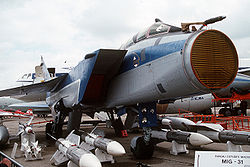- Zaslon radar
-
Zaslon MiG-31 showing Zaslon antennaCountry of origin Russia Introduced 1975 Type PESA Frequency X-band/L-band Range 200 km max Diameter 1.1 meters Azimuth +/-70 Elevation +70/-60 The Russian (former USSR) BRLS-8B "Zaslon" is an all weather multimode airborne radar developed between 1975 and 1980 by the Tikhomirov Scientific Research Institute of Instrument Design as part of the weapons control system of the MiG-31 supersonic interceptor. The NATO codename for the radar is Flash Dance with the designations "SBI-16", "RP-31", "N007" and "S-800" also being associated with the radar.
Contents
Description
The Zaslon is a Pulse-Doppler radar with a passive electronically scanned array (PESA) antenna and digital signal processing. The antenna used by the Zaslon is actually a multi-channel system comprising two separate electronically controlled arrays, an X-band radar with 1700 emitters and a L-band transponder with 64 emitters brought together into a single antenna [1]. The antenna has a diameter of 1.1 meters and is fixed in position with a scanning sector of +/-70 degrees in azimuth and +70/-60 degrees in elevation [2]. The X-band components of the radar uses reciprocal ferrite phase shifters that allow the radar to position beams in around 1.2 msec [1]. This high performance is one of the big advantages of phased array radars compared with the previous generation of mechanically scanned arrays which take seconds to perform the same functions as a phased array. The detection performance of the Zaslon radar is stated to be 200 km against a target with a Radar cross section (RCS) of 16 m2, the radar can track up to 10 targets while engageing 4 of those at any one time with either R-33 radar guided or R-40, R-60 IR guided air to air missiles [2].
The radar was a landmark in aviation since it was the first time a PESA radar (previously found only on ground based systems or big bomber) had been installed in a jet fighter. The Zaslon radar was publicly unveiled at the 1991 Paris Airshow with its associated MiG-31 interceptor, the Russians even removing the radome of the fighter to allow the Zaslon's revolutionary antenna to be seen. Also at Paris was the US F-117 Nighthawk (revolutionary for its use of stealth technology) which the Russians suggested should take to the air with the MiG-31 to see if the Zaslon could detect the F-117. Unfortunately no such contest was ever conducted though Russian experts were confident that Zaslon would have been able to detect the F-117 during flight [1].
Zaslon uses an Argon-15A computer (first airborne digital computer designed in USSR by Research Institute of Computer Engineering (NICEVT, currently NII Argon). [3][4]
Variants
- Zaslon-A
- Zaslon-M. The development of the modernised MiG-31M in 1983 and later the MiG-31BM interceptors also led to the introduction of an improved Zaslon fire control radar, the Zaslon-M. The Zaslon-M differs from the original Zaslon radar in firstly having a larger antenna, increased to 1.4 meters in diameter and an increased detection range of 300–400 km. Tracks 24 targets at once, engages 6. In April 1994 used with an R-37 to hit a target at 300 km distance. The radar is also compatible with the advanced R-37 radar guided air to air missile[citation needed].
- Zaslon-AM, an upgraded version by Leninets and NIIP, Argon-15A replaced with Baget processors
See also
- MiG-31
- List of radars
References
- ^ a b c "Weapon Control System "Zaslon" with Phased Array for the MiG-31 Fighter Aircraft at Tikomirov Website". http://www.niip.info/main.php?page=raz_sky_zaslon.
- ^ a b "Rosoboronexport Catalogue". http://www.rusarm.ru/cataloque/airf0rces_cataloque.html.
- ^ Zaslon radar at MiG Design Bureau extra web-site
- ^ Argon-15 at www.computer-museum.ru
Russian and former Soviet military designation sequences N radars N001 Myech/Panda · N002/N006/N008/RP-23 Ametist/Saphir-23M · N005/RP-25 Saphir-25 N007/RP-31 Zaslon · N010 Zhuk · N011 Bars · N012 · N014 · N019/RP-29 Rubin/Topaz · N025 · N035 Irbis · N050
P radar stations, missiles, rockets P-1 Strela (Shchuka) · P-3 radar · P-5 Pyatyorka · P-8 radar · P-10 radar · P-12 radar · P-14 radar · P-15 radar · P-18 radar · P-19 radar · P-20 radar · P-15 Termit · P-30 radar · P-35 radar · P-40 radar · P-70 radar · P-20M/P-70 Ametist · P-80 Zubr · P-100 Oniks · P-120 Malakhit · P-270 Moskit · P-120 Malakhit · P-500 Kliver radar · P-500 Bazalt · P-700 Granit · P-750 Grom · P-800 Oniks · P-1000 Vulkan
R missiles, rockets R, RD engines Others Categories:- Aircraft radars
- Science and technology in the Soviet Union
- Russian and Soviet military radars
Wikimedia Foundation. 2010.

